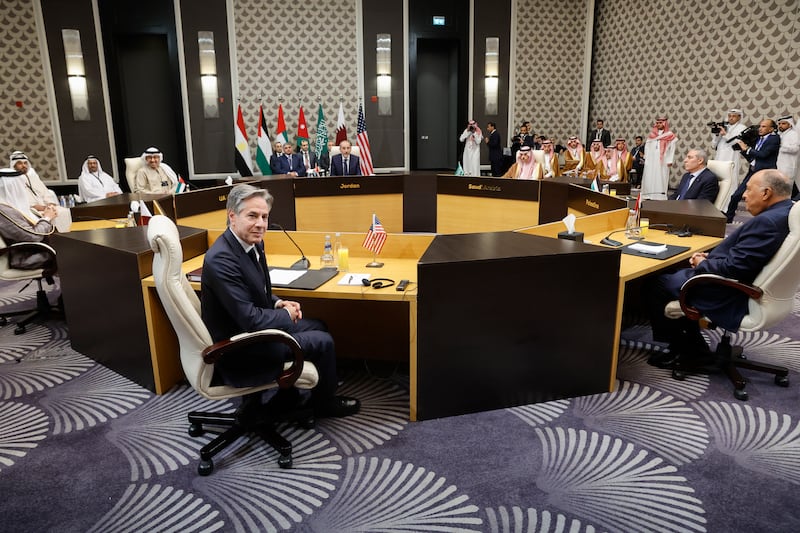Arab leaders publicly pressed US secretary of state Antony Blinken on Saturday to secure an immediate ceasefire in Gaza, hours after Palestinians said an Israeli air strike killed at least 15 people in a United Nations-run school being used as a shelter.
In a rare open display of disagreement, the top US diplomat pushed back as he stood next to his Jordanian and Egyptian counterparts at a press conference, saying a ceasefire would only let Hamas militants regroup.
World and regional powers have failed to reach any consensus on how to deal with the escalating conflict in the four weeks since fighters from Hamas, which runs the Gaza Strip, burst over the border, killing 1,400 people and taking more than 240 others hostage.
Israel has since struck Gaza from the air, imposed a siege and launched a ground assault, stirring global alarm at humanitarian conditions in the enclave, Gaza health officials said on Saturday, killing more than 9,488 Palestinians.
[ ‘Gaza was an open-air prison. Now it is an open-air graveyard’Opens in new window ]
Mr Blinken met the Saudi, Qatari, Emirati, Egyptian and Jordanian foreign ministers in Amman. “Right now we have to make sure that this war stops,” Jordanian foreign minister Ayman Safadi told the press conference afterwards.
Mr Blinken said all were agreed on the need for peace and that the current status quo in Gaza could not hold, but he acknowledged there were differences between Washington, which has called only for pauses to let aid into Gaza, and its allies.
“A ceasefire now would simply leave Hamas in place, able to regroup and repeat what it did on October 7th,” said Mr Blinken, who was on his second trip to the region since Israel and Hamas went to war.
Palestinian witnesses said Israel hit Al-Fakhoura school in Jabalia, where thousands of evacuees were living, on Saturday morning.
The Israeli military said a preliminary inquiry suggested it had not targeted the location “but the explosion may have been a result of IDF fire aimed at another target”. The circumstances were “under review,” it added.

Reuters footage of the aftermath showed broken furniture and other belongings lying on the ground, patches of blood on the ground and on food, and people crying.
“I was standing here when three bombings happened, I carried a body and another decapitated body with my own hands,” a young boy said in video obtained by Reuters, crying in despair. “God will take my vengeance.”
Nearby, a resident comforted a woman in shock.
One man asked angrily: “Since when has it become normal to strike shelters? This is so unfair.”
Juliette Touma, director of communications for the UN Palestinian refugee agency (UNRWA), confirmed the UN-run school, which is in the Gaza City area, had been hit.
“At least one strike hit the schoolyard where there were tents for displaced families. Another strike hit inside the school where women were baking bread,” Ms Touma said by phone.
The ministry of health in Gaza said another Israeli missile strike killed two women at the door of the Nasser Children’s Hospital. Several more people were injured, it said. There was no immediate Israeli response to that report.
A series of reported air strikes over the past week have devastated parts of the Jabalia refugee camp, the largest of several refugee settlements in Gaza, killing at least 195 people, according to Palestinian authorities.
Israeli defence minister Yoav Gallant told a press conference that Israel’s forces had delivered a “hard blow” to Hamas, destroying communications hubs, bunkers and tunnel networks over the past two days and killing 12 commanders since the start of the war.
Israel last month ordered all civilians to leave the northern part of Gaza, including Gaza City, and head to the southern part of the enclave.
The military said it would enable Palestinians to travel on a main Gaza highway, the Salah a-Din road, during a three-hour window on Saturday afternoon. “If you care about yourself and your loved ones, heed our instruction to head south,” it said in a social media post in Arabic.
Several residents told Reuters they were too afraid to use the road. Many posted warnings on social media that Israeli tanks were stationed there.
US special envoy David Satterfield said in Amman that between 800,000 to a million people had moved to the south of the Gaza Strip, while 350,000-400,000 remained in northern Gaza City and its environs.
Israel has imposed a full blockade on Gaza and allowed very little aid in from Egypt, saying it fears it would be stolen by Hamas. Satterfield said there were no recorded instances of Hamas seizing aid.
In what appeared to presage a widening of Israel’s ground offensive, the military issued footage showing armoured bulldozers churning up northern Gaza areas in what it described as “creating access routes for forces”.
A combined tank and combat engineering unit carried out a “pinpoint raid” in the southern Gaza Strip “to map out buildings and neutralise explosives”, it said.
Lebanon’s Hizbullah said it carried out simultaneous attacks on Israeli positions at the Lebanese border on Saturday, as residents of south Lebanon reported some of the fiercest Israeli strikes yet during weeks of cross-border clashes.
The Israeli army said its warplanes had struck Hizbullah targets in response to an earlier attack from Lebanese territory, and was accompanying the air strikes with artillery and tank shelling.
The Hizbullah movement in Lebanon is backed by Iran, as is Hamas. Hizbullah leader Sayyed Hassan Nasrallah on Friday warned that conflict could spread if Israel continued bombing Gaza.
Pro-Palestinian protests took place on Saturday in European capitals including London, Berlin and Paris to call for an immediate ceasefire. – Reuters
Israeli prime minister Binyamin Netanyahu pointedly snubbed Mr Blinken’s blunt warning that Israel risks losing any hope of an eventual peace deal with the Palestinians unless it eases the humanitarian crisis in Gaza. – Reuters












